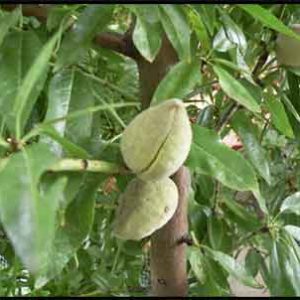Prunus (Amygdalus) amygdalus (dulcis)
Almonds
Origin
Syria to Pakistan
Climate
Almonds are grown in home gardens from the inner Mid-West to Perth and the South West. They are deep-rooted and can tolerate dry conditions. Hot summers with low humidity are needed and trees are not affected by mild frost. Trees need 300-600 chilling hours below 7°C to set fruit.
Plant Description
The deciduous trees grow to 4 to 6m, but dwarf varieties may grow to 3m high by 3m wide.
Relatives
Rosaceae family. Almonds are related to other stonefruits such as apricots, cherries, peaches and plums, loquats and many more. Peaches are their closest fruiting relative.
Soils
Almonds prefer lighter soils but can be grown on loams to clay loams with good drainage. They will not tolerate waterlogging, and are very susceptible to damage from excess salt. Irrigation water should have total salts level less than 700 ppm.
Propagation
Seedlings are variable – better to use grafted plants. Almond scions can be grafted on a number of different kinds of rootstocks, including peach. Rootstocks are chosen for various purposes, such as dwarfing and resistance to nematodes and various diseases.
Cultivars
Sweet, soft-shelled varieties are preferable as nuts can be cracked by hand pressure. The cvs All-In-One and Papershell are available in local nurseries. They are dwarf, soft-shelled varieties and are self pollinating. Commercial cvs such as Nonpareil may be difficult to obtain in retail nurseries and need a pollinating variety within 50m. The pollinating variety may also be planted in the planting hole of the main variety.
Flowering and Pollination
The ornamental, white or pink flowers are fragrant and are borne in August. Rain at flowering may affect pollination and increase fungal infection. Trees are pollinated by bees and other insects.
Cultivation
Grow in full sun. Use a complete NPK fertiliser every two months in the warmer months from September onwards, and mulch around the plants. Good irrigation is needed, especially from October to January.
Wind Tolerance
Good tolerance, but strong winds may affect pollination.
Pruning
With newly-planted young trees, cut the main shoot at 0.6m to allow branching, then prune to a vase shape. Little pruning and training is needed for established trees. Weak growth, diseased and dead branches should be removed.
The Fruit
The fruit is a drupe with a thin, leathery covering, but it is the nut that is in culinary use. The drupe is flattened and contains a single seed.
Fruit Production and Harvesting
Trees commence bearing 3-4 years after planting. Fruit thinning is not required. Fruiting occurs on old and new wood and harvesting in Perth is from February to April. Harvest when the hull starts to open. Commercial growers shake the tree stems with special machines. In a home garden, nuts are hand-picked or they’re knocked off with poles. A plant may yield 1.5-2.0 kg per season. Dehusk promptly and then shells can be removed when required. In-shell nuts will store for several weeks or months at ambient temperatures.
Fruit Uses
The nuts are eaten fresh or roasted. They are also used in cakes and confectionary, as whole or sliced nuts. ‘Nut milk’ is made from ground nutmeats soaked in water and then pressed.
Pests and Diseases
Trees should be netted to avoid bird and rat damage to immature and mature nuts; bird pests include cockatoos, parrots and ravens. Dwarf trees are easier to net. Spraying may be needed in winter and early spring to control anthracnose and shot-hole diseases.
Comments
Australia is now the second biggest producer in the World, with most being grown in the Robinvale-Mildura area and only a small contribution from the Swan Valley in WA. There is a misconception that the hard shelled varieties of almonds are less prone to bird damage: this is untrue. The nuts are often ravaged by birds when very small and still soft.
